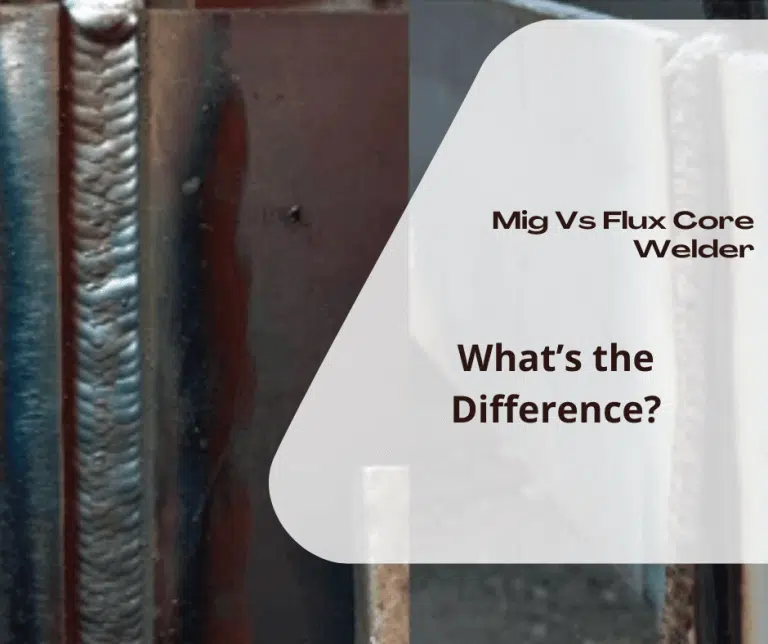Choosing the Best Mig Welder
Affiliate Disclaimer: migweldercart.com provides industry expertise and research to its readers. You help us by using the links to our carefully picked items, which may earn us a little commission.
Many of us learn about MIG welding since it produces clean beads that even amateur welders can accomplish when we are initially introduced to welding. When I originally learned to weld, I assumed MIG solid wire would be superior to flux-cored.

But I was mistaken; flux-cored wire has several advantages and is the preferable option sometimes. You can improve as a welder if you know when to use a solid wire and when to use a flux-cored wire.
This is only one possible way to sum up, the situation quickly. Solid MIG wire is the way to go when working with thin material.
Flux-cored wire, on the other hand, is preferable while working outside in the wind. Again, flux-cored wire is the way to go when welding cast iron or galvanized steel. Finally, MIG welding using solid wire is the method of choice when working with aluminum (and possibly a spool gun).
To begin with, I was curious as to what the distinction was. Then I inquired as to which was superior and which was less expensive. You get the point; I had many questions regarding the two choices, like most people.
If you’re a beginner with comparable inquiries, you’ve found the proper spot to ask them. Here, we’ll compare and contrast the advantages and disadvantages of these two common welding techniques and discuss when and why to employ each.
MIG vs Flux-Core Comparison Table
| MIG | Flux-cored | |
|---|---|---|
| Setup/Learning curve | Moderate | Moderate |
| Wire Cost |  $$ $$ |  $$$ $$$ |
| Requires Gas Tank |  Yes Yes |  No No |
| Operating Cost | $$ | $$ |
| Surface prep |  Bright white metal is best Bright white metal is best |  Works through paint, rust, and dirt Works through paint, rust, and dirt |
| Wind |  Indoor, Less than 5 MPH Indoor, Less than 5 MPH |  Outdoor, Up to 35 MPH Outdoor, Up to 35 MPH |
| Bead Appearance |  No slag, little spatter No slag, little spatter |  Slag & spatter Slag & spatter |
| Post clean Up |  Very Little Very Little |  Slag & Spatter Cleaning Slag & Spatter Cleaning |
| Thin stock |  Down to 24 ga. Down to 24 ga. |  1/8 or thicker 1/8 or thicker |
| Thick stock |  Acceptable with enough power Acceptable with enough power |  Good penetration up to 3/8in. Good penetration up to 3/8in. |
| Cast iron |  Possible, but weaker weld Possible, but weaker weld |  Better penetration, stronger than MIG Better penetration, stronger than MIG |
| Aluminum |  Cleaner than stick Cleaner than stick |  Possible but messier Possible but messier |
| Mobility |  Harder with gas tanks Harder with gas tanks |  Easier without gas tanks Easier without gas tanks |
Many may argue over which of the several welding techniques is the best. MIG and Flux Core welding are two of the most used methods. However, neither of these approaches is inherently better than the other; they each have their benefits and drawbacks. If you’re just getting started with welding, it might be tough to figure out which technique is best for you.
Let’s start by contrasting the two approaches so you can see the differences and make an informed choice.
The filler metal for the weld is supplied by a spool of wire in each process; the main variation is in the kind of wire used. The difference between MIG welding and flux core welding is that the former employs a solid wire. At the same time, the latter is tubular and contains flux, thus the name.
The meaning may be found in the flux, where a significant distinction between the two approaches emerges.
Hot metal cannot touch regular air during welding since it might result in a poor weld. This is accomplished by using a shielding gas during MIG welding. The MIG welder will have a shielding gas tank attached to it, and it will automatically release gas to cover the weld as needed. In MIG welding, you may use argon, a mixture of argon and carbon dioxide, pure carbon dioxide, or a tri-mix, which combines all three gases. The welding of stainless steel is the most common use of tri-mix.
Regarding the flux core, here is where the center of the wire comes into play. Using flux core wire results in the central flux becoming hot and releasing gas, sealing off the work area from the ambient air. Thus, it is possible to weld without using a separate gas tank, making this process more convenient for many people. However, a kind of flux core welding employs a gas tank known as a double-shielded flux core wire.
It’s a never-ending argument among welders whether flux core or MIG welding produces a stronger weld. The reality is that they’re somewhat similar to one another. Both techniques may provide a durable weld suitable for most purposes. Both wires are up to par with what the American Welding Society requires, so you can count on getting at least 70 ksi of tensile strength from them. Of course, the skill and expertise of the welder and whether or not the weld is executed properly also play a role in determining the weld’s ultimate strength.
Although both flux core welding and metal inert gas welding are often used, it isn’t easy to draw direct comparisons between them in terms of metal penetration. However, since there are other variables than welding technique that affect penetration, this is the case. For example, consider the metal’s thickness and the welding machine’s voltage and amperage settings.
Most of the time, the best welding technique is based on personal choice. Some of those who advocate for one way may have been exposed to that strategy first and found it to be the most successful. All this proves is that novice welders should try both and discover which works best for them and their project.

M Hasan
I’m a professional welder and a writer at heart, so I wanted to share the welding expertise I’ve gathered over the years. In addition, I hope our posts motivate others to start welding. I have well-researched. I promise you’ll find honest advice on choosing the best MIG welder here- www.migweldercart.com
Check Out My Reviews On The 10 Best Mig Welder.
Disclaimer:
Our website, www.migweldercart.com, participates in the Amazon Services LLC Associates Program. As an Amazon Associate, we collect commissions on qualifying purchases, but our readers have no difference in price. Our website’s products, brands, trademarks, and pictures belong to their respective owners.